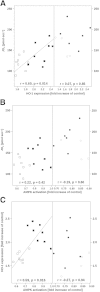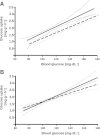Effects of glycemic control on glucose utilization and mitochondrial respiration during resuscitated murine septic shock
- PMID: 26266919
- PMCID: PMC4678133
- DOI: 10.1186/2197-425X-2-19
Effects of glycemic control on glucose utilization and mitochondrial respiration during resuscitated murine septic shock
Abstract
Background: This study aims to test the hypothesis whether lowering glycemia improves mitochondrial function and thereby attenuates apoptotic cell death during resuscitated murine septic shock.
Methods: Immediately and 6 h after cecal ligation and puncture (CLP), mice randomly received either vehicle or the anti-diabetic drug EMD008 (100 μg · g(-1)). At 15 h post CLP, mice were anesthetized, mechanically ventilated, instrumented and rendered normo- or hyperglycemic (target glycemia 100 ± 20 and 180 ± 50 mg · dL(-1), respectively) by infusing stable, non-radioactive isotope-labeled (13)C6-glucose. Target hemodynamics was achieved by colloid fluid resuscitation and continuous i.v. noradrenaline, and mechanical ventilation was titrated according to blood gases and pulmonary compliance measurements. Gluconeogenesis and glucose oxidation were derived from blood and expiratory glucose and (13)CO2 isotope enrichments, respectively; mathematical modeling allowed analyzing isotope data for glucose uptake as a function of glycemia. Postmortem liver tissue was analyzed for HO-1, AMPK, caspase-3, and Bax (western blotting) expression as well as for mitochondrial respiratory activity (high-resolution respirometry).
Results: Hyperglycemia lowered mitochondrial respiratory capacity; EMD008 treatment was associated with increased mitochondrial respiration. Hyperglycemia decreased AMPK phosphorylation, and EMD008 attenuated both this effect as well as the expression of activated caspase-3 and Bax. During hyperglycemia EMD008 increased HO-1 expression. During hyperglycemia, maximal mitochondrial oxidative phosphorylation rate was directly related to HO-1 expression, while it was unrelated to AMPK activation. According to the mathematical modeling, EMD008 increased the slope of glucose uptake plotted as a function of glycemia.
Conclusions: During resuscitated, polymicrobial, murine septic shock, glycemic control either by reducing glucose infusion rates or EMD008 improved glucose uptake and thereby liver tissue mitochondrial respiratory activity. EMD008 effects were more pronounced during hyperglycemia and coincided with attenuated markers of apoptosis. The effects of glucose control were at least in part due to the up-regulation of HO-1 and activation of AMPK.
Figures


Similar articles
-
Impact of hyperglycemia on cystathionine-γ-lyase expression during resuscitated murine septic shock.Intensive Care Med Exp. 2017 Dec;5(1):30. doi: 10.1186/s40635-017-0140-7. Epub 2017 Jun 14. Intensive Care Med Exp. 2017. PMID: 28616781 Free PMC article.
-
The effect of superoxide dismutase overexpression on hepatic gluconeogenesis and whole-body glucose oxidation during resuscitated normotensive murine septic shock.Shock. 2008 Nov;30(5):578-84. doi: 10.1097/SHK.0b013e31816a6e0f. Shock. 2008. PMID: 18317403
-
Effect of increased cardiac output on hepatic and intestinal microcirculatory blood flow, oxygenation, and metabolism in hyperdynamic murine septic shock.Crit Care Med. 2005 Oct;33(10):2332-8. doi: 10.1097/01.ccm.0000182817.20977.e9. Crit Care Med. 2005. PMID: 16215389
-
Adrenomedullin binding improves catecholamine responsiveness and kidney function in resuscitated murine septic shock.Intensive Care Med Exp. 2013 Dec;1(1):21. doi: 10.1186/2197-425X-1-2. Epub 2013 Oct 29. Intensive Care Med Exp. 2013. PMID: 26266790 Free PMC article.
-
Metabolic Effects of Sodium Thiosulfate During Resuscitation from Trauma and Hemorrhage in Cigarette-Smoke-Exposed Cystathionine-γ-Lyase Knockout Mice.Biomedicines. 2024 Nov 12;12(11):2581. doi: 10.3390/biomedicines12112581. Biomedicines. 2024. PMID: 39595147 Free PMC article.
Cited by
-
Intestinal oxygen utilisation and cellular adaptation during intestinal ischaemia-reperfusion injury.Clin Transl Med. 2025 Jan;15(1):e70136. doi: 10.1002/ctm2.70136. Clin Transl Med. 2025. PMID: 39724463 Free PMC article. Review.
-
The H2S Donor Sodium Thiosulfate (Na2S2O3) Does Not Improve Inflammation and Organ Damage After Hemorrhagic Shock in Cardiovascular Healthy Swine.Front Immunol. 2022 Jun 16;13:901005. doi: 10.3389/fimmu.2022.901005. eCollection 2022. Front Immunol. 2022. PMID: 35784322 Free PMC article.
-
Impaired Glucocorticoid Receptor Dimerization Aggravates LPS-Induced Circulatory and Pulmonary Dysfunction.Front Immunol. 2020 Jan 23;10:3152. doi: 10.3389/fimmu.2019.03152. eCollection 2019. Front Immunol. 2020. PMID: 32038649 Free PMC article.
-
Cigarette smoke exposure reduces hemorrhagic shock induced circulatory dysfunction in mice with attenuated glucocorticoid receptor function.Front Immunol. 2022 Sep 12;13:980707. doi: 10.3389/fimmu.2022.980707. eCollection 2022. Front Immunol. 2022. PMID: 36172380 Free PMC article.
-
Hyperglycemia, oxidative stress, and the diaphragm: a link between chronic co-morbidity and acute stress?Crit Care. 2014 Jun 10;18(3):149. doi: 10.1186/cc13913. Crit Care. 2014. PMID: 25171553 Free PMC article.
References
-
- Watanabe Y, Singamsetty S, Zou B, Guo L, Stefanovski D, Alonso LC, Garcia-Ocana A, O'Donnell CP, McVerry BJ. Exogenous glucose administration impairs glucose tolerance and pancreatic insulin secretion during acute sepsis in non-diabetic mice. PLoS One. 2013;8:e67716. doi: 10.1371/journal.pone.0067716. - DOI - PMC - PubMed
-
- Esposito K, Nappo F, Marfella R, Giugliano G, Giugliano F, Ciotola M, Quagliaro L, Ceriello A, Giugliano D. Inflammatory cytokine concentrations are acutely increased by hyperglycemia in humans - role of oxidative stress. Circulation. 2002;106:2067–2072. doi: 10.1161/01.CIR.0000034509.14906.AE. - DOI - PubMed
LinkOut - more resources
Full Text Sources
Other Literature Sources
Research Materials
Miscellaneous
